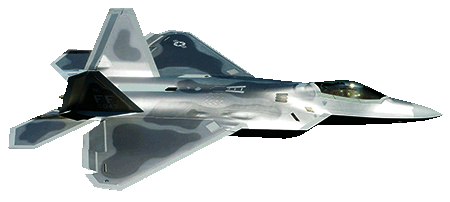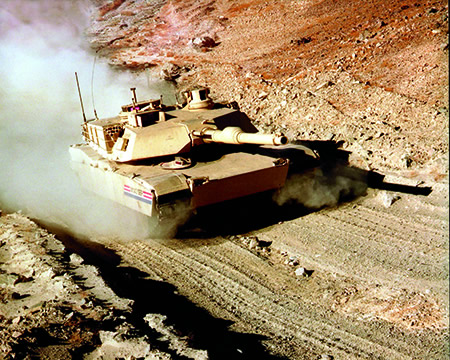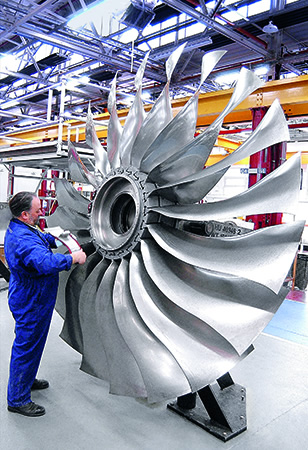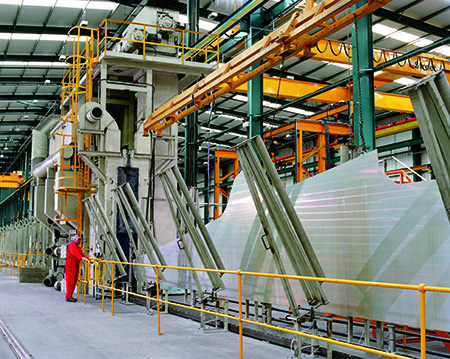
Curtiss-Wright created actuation systems to open and close the weapons bay doors of the F-22 Raptor in record speed, helping ensure the aircraft retains its stealth profile during missions.

Curtiss-Wright's digital fire-control computer on the U.S. Army's M1A2 Abrams main battle tank stabilizes the tank's turret for target accuracy while traveling over rough terrain. This technology enables gunners to "fire on the fly" rather than requiring the tank to "stop, drop and shoot."

Curtiss-Wright provides laser peening services on the Rolls-Royce Trent 1000 turbine engine, which is a power plant for the Boeing 787 aircraft.

A 100-foot-long lower wing skin for the A380 aircraft being readied for shot peening. Curtiss-Wright shot peen forms all the wing skins on Airbus commercial aircraft.
Motion Control
Continuing a legacy of performance in aviation, Curtiss-Wright provides innovative flight control and utility actuation systems to support nearly every U.S. Air Force fighter aircraft program, as well as the latest in integrated electronics and embedded computing. The next-generation F-22 Raptor employs unprecedented stealth technologies, including storing weapons internally rather than hanging from the wing, to fly virtually undetected by enemy radar. Curtiss-Wright's actuation systems open and close the main and side weapons bay doors almost instantaneously, boosting mission effectiveness and pilot safety. Curtiss-Wright's high-performance technologies can be found onboard nearly every military aircraft in development, including the F-35 Lightning II, the V-22 Osprey and the P-8A Poseidon, as well as the Pilatus PC-21 turboprop trainer, which uses our embedded computing technology to modify the control panel to emulate any fighter jet for training purposes. In addition, our advanced electronics and sensors have enabled significant upgrades to the performance of military helicopters, including the Black Hawk, Apache, Chinook and CH-53K.
On the ground, Curtiss-Wright provides sophisticated electronic upgrades and embedded computing products for the Bradley Fighting Vehicle, the Abrams Tank and the Stryker Mobile Gun System. Our turret aiming and stabilization systems and suspension systems are in service on many of the leading military ground vehicles used by NATO members, such as the Piranha, Pizarro and Puma Armored Infantry Fighting Vehicles, to name a few.
Curtiss-Wright's industry-leading rugged embedded computing technology is meeting 21st century military requirements. A high-performance, ruggedized radar processing subsystem from Curtiss-Wright helps enable the mobile Ground/Air Task Oriented Radar (G/ATOR) system to perform aircraft detection and tracking, cruise-missile detection and tracking, ground weapon location and air traffic control. Our central electronics chassis is integral to the Airborne Laser Mine Detection System (ALMDS), which rapidly detects and locates surface and near-surface moored mines so they can be neutralized before damaging military and commercial ships. And our innovative step frequency antenna and GeoScope Ground Penetrating Radar processing generates high-resolution three-dimensional images of buried objects, which is critical for the identification of unexploded ordnance.
Commercial applications range from the stratosphere to the Formula 1 racetrack. Curtiss-Wright provides a variety of flight control systems, sensor management and data recording on every commercial jet in production. These mission-critical systems ensure smooth take-off and landing, as well as monitoring of flight operations. On helicopters, Curtiss-Wright's rotor ice protection system senses and removes icy build-up on rotor blades to enable safe flight during severe weather conditions. And on the racetrack, highly customized sensors provide Formula 1 racecars with superior steering, suspension, gearbox and accelerator controls.
Metal Treatment
Laser peening takes the centuries old metal peening concept to a new level of performance. Instead of using metal, ceramic or glass shot, the peening is accomplished with bursts of laser energy precisely directed at specific portions of a component. The laser beam directs a brief pulse of energy, equivalent in power to the instantaneous output of a nuclear power plant, at the component. Shock waves created by the laser beam compress the metal surface, strengthening its resistance to cracking and corrosion. This proprietary laser technology has just begun to set performance standards in the commercial market. For example, laser peening is used to form the complex curvatures of wing sections on Boeing's new 747-8, which will help achieve the improved aerodynamics of this aircraft design.
To expand our portfolio of sophisticated metallurgical processes, Curtiss-Wright is pioneering solid film lubricant (SFL) coating technology. Used across industry sectors, these coatings protect components against adverse operating conditions such as high temperatures, extreme loads, corrosion, wear, friction and abrasion. The company also specializes in applying parylene coatings to medical devices, including rubber/silicone seals and wire-forming mandrels used in the manufacture of catheters, as well as for niche electronic, oil and gas, and general industrial parts.
